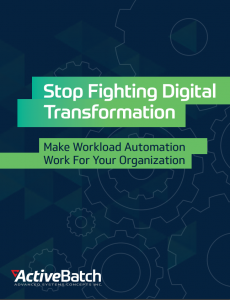Industry analysts like Gartner and Enterprise Management Associates (EMA) have spoken, and if you’re not yet using Workload Automation (or you’re not using it to its full potential) you will fall behind the competition. The benefits of Workload Automation span every department in the organization, and if the right solution is properly leveraged, it can make a huge business impact.
Here are the 3 reasons why business and IT success rely on a strong Workload Automation solution.
Improved IT Efficiency
In Gartner’s 2017 Hype Cycle for I&O Automation, leading analyst Robert Naegle covers everything IT Workload Automation-related, from the definition, to different tools, to advice, to business impact.
When it comes to business impact, Naegle’s claims are straightforward:
“Workload Automation tools can help reduce the cost of operations by automating many manual processes, reducing redundancy, eliminating duplication and human errors, and by making systems more agile.”
The pace of business and IT is accelerating, digital transformations are well underway, and everyone is doing what they can to keep pace with revolutions in industry and marketplace. By eliminating duplication and human errors while making systems more agile, organizations can focus on higher level tasks, increasing efficiency and moving organizations forward faster.
Optimized File Transfers
Enterprise Management Associates (EMA), a leading IT analyst firm, released their multi-dimensional analysis of the Workload Automation marketplace. Supported by data from an in-depth analysis of 14 vendors, Dan Twing, President and COO of EMA, compared and ranked leading Workload Automation solutions on solution impact and cost efficiency:
“EMA believes that modern, enterprise-class workload automation tools are the most logical place to manage and control repetitive workflows, including file transfers.”
The amount of data that needs to be encrypted, decrypted, transferred, and stored increases every day. Managing and controlling repetitive workflows such as managed file transfers ensures that this data is transferred reliably, securely, and timely.
Managing File Transfers with a Workload Automation solution not only increases efficiency of file transfers, but increases productivity and reliability, improves integrations, and extends visibility and control over them.
Superior Cloud-Resource Management
As the amount of data that needs to be processed continues to increase, more and more IT teams are turning to cloud computing to help manage growing workloads. Workload Automation plays a vital role in managing virtual and cloud resources and can mean the difference between effective, efficient cloud computing, and operations ridden with hidden costs.A Workload Automation solution that offers automated provisioning and deprovisioning of virtual and cloud-based resources, based on both historical and predictive analytics, can bring machine learning to the cloud environment and help IT automate and optimize resource usage.
Implementing a Workload Automation solution can also help control unwanted cloud costs, minimizing the risks associated with cloud computing.
The EMA Radar Report commends ActiveBatch Workload Automation on its standout cloud features, such as Smart Queue and Managed Queue, and its prebuilt integrations with VMware, Amazon EC2, Microsoft Azure, and SCVMM. The report states that these features and capabilities “make ActiveBatch a strong choice for anyone relying on hybrid or multi-cloud to optimize resource usage.”

